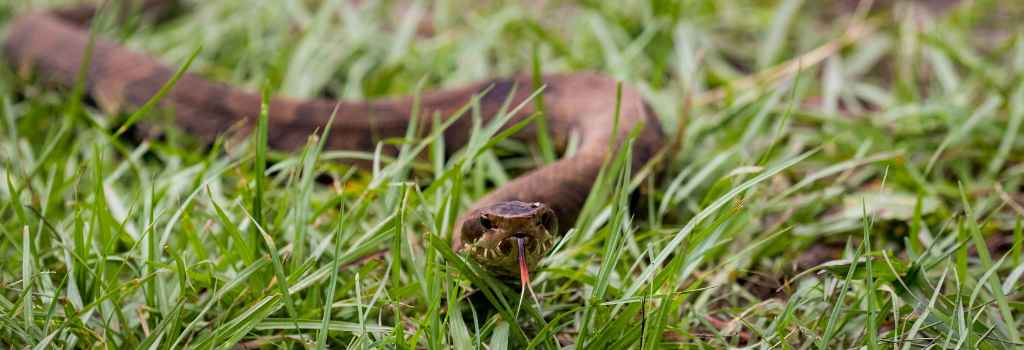Texas is home to a wide range of snakes, from harmless garden snakes to highly venomous species that can significantly harm our cats and dogs. Knowing which snakes are most common in your area — and how to recognize the risks they present — is an important part of keeping your pets safe and healthy during every walk or outing. In this blog, I’ll cover which species are the most dangerous venomous snakes across the state, where they like to live, when you might encounter them, and what to do in the event that your pet is bitten by one.
Types of Snakes in Texas & How They Can Harm Our Pets
A variety of snake species can be found all throughout Texas, with some posing more dangers to our pets than others. Of the over 100 species and subspecies of snakes present in Texas, 15% are venomous. The venomous snakes that you're most likely to encounter in Texas include those classified as pit vipers (which include rattlesnakes, copperheads, and cottonmouths) and coral snakes.
Rattlesnakes
Texas is home to 10 different species of rattlesnakes, with the Western diamondback rattlesnake the most commonly encountered variety. They can often be found in dry, rocky areas or areas with scrub or brush.
Rattlesnake venom presents a serious danger to pets due to its varied effects. Although venom composition differs among species, it generally acts as a hemotoxin, harming blood, vessels, and tissues. This can result in issues like abnormal blood clotting, swelling, bleeding, tissue damage, pain, and potentially systemic shock. Additionally, some rattlesnake venoms contain neurotoxins, which can lead to further complications such as paralysis and respiratory distress.
Copperheads
Southern copperheads, broadbanded copperheads, and Trans-Pecos copperheads can all be found in different areas of Texas in places with good ground cover and a lot of hiding spots. While still dangerous for both people and pets to encounter, copperhead snakes across Texas generally have less potent venom than the rattlesnake varieties we discussed above.
Like rattlesnake venom, the venom of copperhead snakes is hemotoxic and tissue-damaging. However, copperheads are a type of snake that is capable of dry-biting, or biting an animal without injecting its venom, or at the very least injecting a small amount of venom, which can change health outcomes for pets that have been bitten by a copperhead.
Cottonmouths
Cottonmouths, also known as water moccasins, are primarily found in eastern and southeastern parts of Texas, where there are wetter environments with more bodies of water nearby. These snakes are semi-aquatic, making them a danger not only to our pets on land but also while they’re taking a dip in a pond or walking on the edge of a stream.
Like the other venomous snakes found across Texas, cottonmouth venom is also hemotoxic and cytotoxic, commonly resulting in tissue necrosis, swelling, bleeding, and severe pain for the people or animals affected by it.

What Happens When a Snake Bites a Dog or Cat
Even a mild or “dry” snake bite can be dangerous for a cat or dog and should be treated as a medical emergency. If your pet is bitten, symptoms can appear quickly and become severe. The same bite that large animals and humans may survive can be much more dangerous for our pets due to differences in venom concentration, due to the smaller size and lower weights of our dogs and cats.
The most noticeable sign of a snake bite in dogs and cats is the visible puncture wound that will look like an indentation of the snake’s fangs. Other common signs that your cat or dog has been bitten by a snake include swelling, pain, bleeding, and bruising around the site of the bite.
Snakebite Symptoms in Dogs and Cats
As venom spreads after a cat or dog has been bitten by a snake, pets may show lethargy, weakness, drooling, trembling, vomiting, or difficulty breathing. Severe cases can lead to collapse or seizures, so it is imperative to seek out veterinary care as soon as possible in the event of your pet being bitten by a snake.
When Snake Encounters Happen In Texas
Snake encounters are most likely during the warmer months, particularly in spring, when snakes emerge from winter brumation and are actively hunting and seeking mates. Activity remains high through early summer and picks up again in late summer to early fall, when many snakes are giving birth or hatching. The time of day also matters; these snakes are most active during the cooler hours of dawn and dusk, and in the heat of summer, they often shift to evening or nighttime activity.
Copperheads may be more noticeable during cicada emergence seasons, as they feed heavily on cicadas near oak trees. While encounters are far less common in the colder winter months, pet owners should remain especially cautious in spring and late summer, keeping pets leashed and supervised during walks at dawn, dusk, or nighttime.
Venomous snakes generally prefer to avoid confrontation and bite only when they feel threatened. However, pets can still be bitten accidentally while exploring or while on walks. Curious dogs and cats may sniff, paw at, or stumble upon a resting snake without realizing the danger that these slithery reptiles present to them. Many bites occur when pets unknowingly approach snakes hiding in tall grass, underbrush, or near water, causing a defensive strike.

What to Do If Your Dog or Cat Is Bitten By a Snake
If your pet is bitten by a snake, seek veterinary care immediately. It doesn’t matter what type of snake bites them or how the bite wound looks; every snake bite needs to be evaluated by a veterinarian immediately and treated accordingly.
After the bite, keep your pet as calm and still as possible, as movement spreads venom more quickly. Carry your pet if you can, and avoid cutting, icing, or using a tourniquet on the bite area. If safe, note the snake’s appearance to inform the veterinarian, but never attempt to capture it. Call the vet clinic or emergency hospital ahead so staff can prepare antivenom and other necessary treatments.
Treating Snake Bites on Dogs and Cats
Pets should receive veterinary treatment as quickly as possible — ideally within the first hour. Early intervention can make the difference between full recovery and life-threatening complications.
Treatment for a snakebite on a dog or cat often includes stabilizing the pet with IV fluids, supplying additional oxygen, and beginning pain control. In some cases, veterinarians may administer antivenom, which neutralizes venom toxins and prevents further damage. Additional care may involve antihistamines, antibiotics, and wound management. Pets are usually hospitalized for monitoring of swelling, blood pressure, clotting, and organ function. Recovery can take days to weeks, depending on the bite severity and the pet’s overall health.
Even with prompt treatment, some pets may develop long-term complications, including tissue damage, scarring, chronic pain, reduced mobility, nerve damage, or organ issues. Follow-up care is important to monitor for lingering effects and to ensure other health complications, like infections, don’t arise.
The Rattlesnake Vaccination for Pets
The rattlesnake vaccine offers partial protection for dogs by stimulating antibodies against venom from rattlesnakes and copperheads. Vaccinated dogs may experience less severe swelling and tissue damage, but the vaccine does not provide complete immunity and does not protect against all venomous snakes, such as cottonmouths or coral snakes. Vaccination is not a substitute for emergency care, and any bitten dog still requires immediate veterinary attention.
Even bites from non-venomous snakes require a veterinary visit. These bites can still cause pain, swelling, bleeding, and infection. A vet can clean the wound, provide antibiotics, and monitor for complications. Prompt care is the safest approach, as pets can deteriorate faster than owners realize.
If you have questions and you'd like to reach out to us, you can call us directly at (817) 326-6262, or you can email us at [email protected]. Don't forget to follow us on social media Facebook, Instagram.
